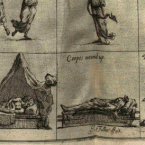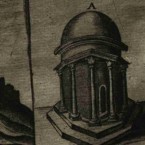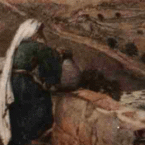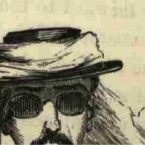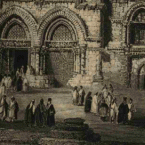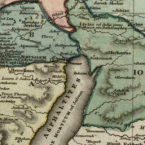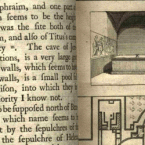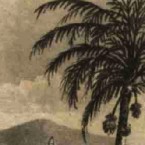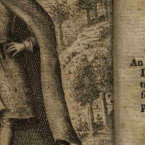Palestine On Display
Once Palestine seems less mythic or ancient and more real, illustrators face the challenge of portraying its landscape and character as precisely as possible. The books in this case put Palestine on display, reveal its topography, offer its nooks up for scrutiny, and make the place appear wherever they go. Straddling a divide between the exuberant and fanciful engagements with place evinced in its earlier books, and the more analytical mappings and exposures of the late nineteenth-century books aligned with the Palestine Exploration Fund, this case aims to demonstrate the variety of styles in which illustration shines lights on Palestine and makes it into an object of investigation.
In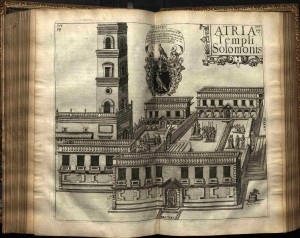 addition to being likely the
addition to being likely the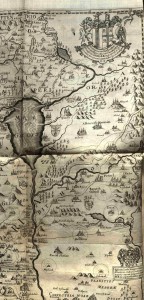
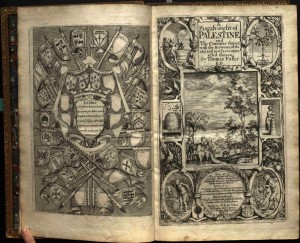 most spectacular of all the
most spectacular of all the
books in this exhibit, and the earliest devoted exclusively to Palestine, Thomas Fuller’s large work offers a plethora of pithy and astute spurs to the traveler among illustrated travel books. In a lovely carnal metaphor, of the subjectivity of geographic visualization he writes, “the bowels of the best Maps are puffed with the humours of fancy, and a skeptical windiness, so that a conjectural Earthquake 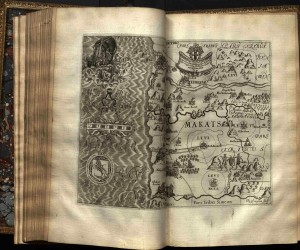 shakes
shakes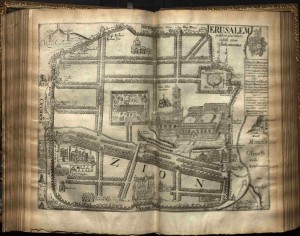 the foundations of the strongest mountains, in the point of their exact situation” (2). Fuller’s alignment of his authorship with a traveling quest is equally compelling: “whilst I am invited with severall pleasing considerations, and delightfull motives,
the foundations of the strongest mountains, in the point of their exact situation” (2). Fuller’s alignment of his authorship with a traveling quest is equally compelling: “whilst I am invited with severall pleasing considerations, and delightfull motives,
to adventure on this work,” he writes in his opening apology, “three Giant-like objections, which must be encountered, do in a manner dishearten me from further proceeding. 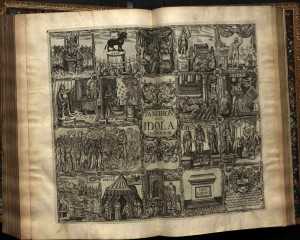 For some will lay to my charge, that the Description of this Countrey 1) Hath formerly been done by many. 2) Cannot perfectly be done by any. 3) If exactly done, is altogether uselesse, and may be somewhat superstitious” (1). Since his is the oldest such work available to those of us who haunt the Fisher Rare Book Library, Fuller’s humble feeling of belatedness is ironic and touching, but also a chastisement to arrogant bibliographers, a reminder of the ghosts behind
For some will lay to my charge, that the Description of this Countrey 1) Hath formerly been done by many. 2) Cannot perfectly be done by any. 3) If exactly done, is altogether uselesse, and may be somewhat superstitious” (1). Since his is the oldest such work available to those of us who haunt the Fisher Rare Book Library, Fuller’s humble feeling of belatedness is ironic and touching, but also a chastisement to arrogant bibliographers, a reminder of the ghosts behind 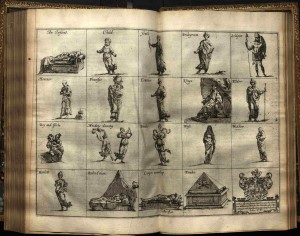 us, the books we don’t see. One of the more remarkable of Fuller’s visualizations is a schematization of the habits and clothes of Jews, which categorizes their bodies and shapes according to their time of life, and state—identifying a “childe,” “a widow,” and “a kinge,” et cetera. Just as in his description of the impressionability of mapmaking, in this plate bodies get confused with landscapes, though here, as in other visualizations of the region, Arab bodies are not explicitly noted as being among its features.
us, the books we don’t see. One of the more remarkable of Fuller’s visualizations is a schematization of the habits and clothes of Jews, which categorizes their bodies and shapes according to their time of life, and state—identifying a “childe,” “a widow,” and “a kinge,” et cetera. Just as in his description of the impressionability of mapmaking, in this plate bodies get confused with landscapes, though here, as in other visualizations of the region, Arab bodies are not explicitly noted as being among its features.
Thi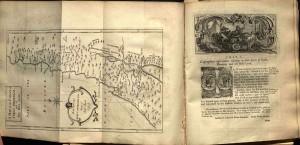 s graceful and exuberant book is among the most elegant but also playful of the exhibit. Rhinoceroses crawl out from behind initial capitals beneath lavish chapter-heading engravings, across from splendid fold-out maps. Nevertheless, the strangely warped view of the “The Land of the Philistines,” and the inutility of Shaw’s plan of Jerusalem makes this reader feel more sympathy for W. H.
s graceful and exuberant book is among the most elegant but also playful of the exhibit. Rhinoceroses crawl out from behind initial capitals beneath lavish chapter-heading engravings, across from splendid fold-out maps. Nevertheless, the strangely warped view of the “The Land of the Philistines,” and the inutility of Shaw’s plan of Jerusalem makes this reader feel more sympathy for W. H. 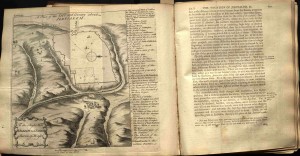 Bartlett’s sense that no practical visualizations of the region had appeared by 1845.
Bartlett’s sense that no practical visualizations of the region had appeared by 1845.
The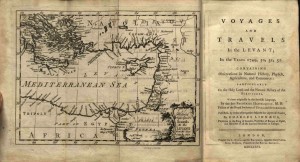 only illustration in this work is its frontispiece fold-out map of the Mediterranean region, including Palestine, but its clarity and precision, as well as the markedly modern elegance of the typography and layout of this book made it an irresistible inclusion. Later Hasselquist’s charming and hilarious animal taxonomies contribute to the general impression the book as a whole creates of foreign subjectivity and the meaning of otherness and elsewhere.
only illustration in this work is its frontispiece fold-out map of the Mediterranean region, including Palestine, but its clarity and precision, as well as the markedly modern elegance of the typography and layout of this book made it an irresistible inclusion. Later Hasselquist’s charming and hilarious animal taxonomies contribute to the general impression the book as a whole creates of foreign subjectivity and the meaning of otherness and elsewhere.
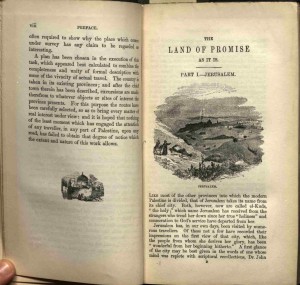 The
The 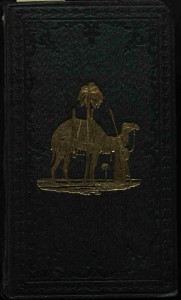 modern design of this book combines images quite fluidly with text settings, using small iconographic depictions of buildings or simple scenes alongside more detailed and extensive plate-set views. The excellent fold-out map of Palestine contributes to the book’s qualities of positivist display, though it was published by the Religious Tract Society. Simultaneously discounting purely impressionistic or spiritual encounters with the
modern design of this book combines images quite fluidly with text settings, using small iconographic depictions of buildings or simple scenes alongside more detailed and extensive plate-set views. The excellent fold-out map of Palestine contributes to the book’s qualities of positivist display, though it was published by the Religious Tract Society. Simultaneously discounting purely impressionistic or spiritual encounters with the 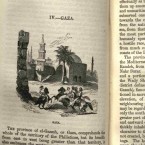 region through religious history, as well as admitting the inevitably subjective nature of seeing land, the author announces in the preface that “It is the object of the present work to describe every place or site of interest or importance in the Land of Promise as it now appears” (vii, italics added). The gold camel embossed on the cover symbolically marks the book as part of what is by 1850 a distinct British tradition of visual representations of Palestine.
region through religious history, as well as admitting the inevitably subjective nature of seeing land, the author announces in the preface that “It is the object of the present work to describe every place or site of interest or importance in the Land of Promise as it now appears” (vii, italics added). The gold camel embossed on the cover symbolically marks the book as part of what is by 1850 a distinct British tradition of visual representations of Palestine.
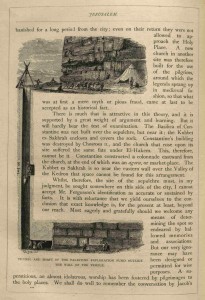 This extremely visual Religious
This extremely visual Religious 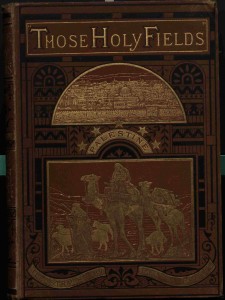 Tract Society publication lays out many detailed wood engravings of maps, locations, and scenes, often set in novel orientations with the text as was
Tract Society publication lays out many detailed wood engravings of maps, locations, and scenes, often set in novel orientations with the text as was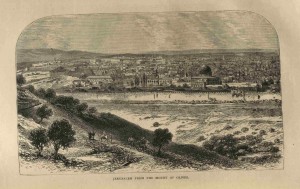 increasingly fashionable at the time. The ostentatious cover includes the by now essential icon of the gold camel and palms, here with the addition of a few other animal figures and a human figure in Arab-identified clothing.
increasingly fashionable at the time. The ostentatious cover includes the by now essential icon of the gold camel and palms, here with the addition of a few other animal figures and a human figure in Arab-identified clothing.
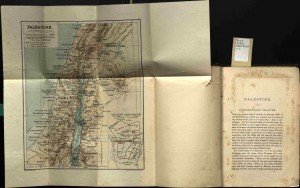 This
This 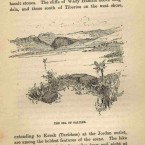 Palestine Exploration Fund publication lays out an extremely meticulous and positivist view of the region through maps and “objective” views.
Palestine Exploration Fund publication lays out an extremely meticulous and positivist view of the region through maps and “objective” views.
Next Display Case: Mobile Subjects
